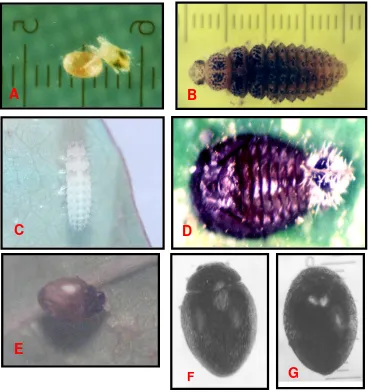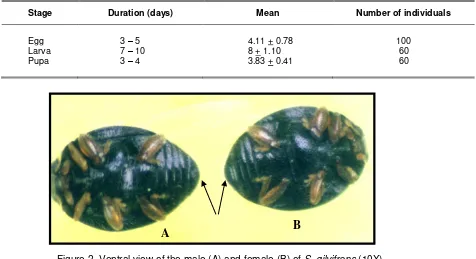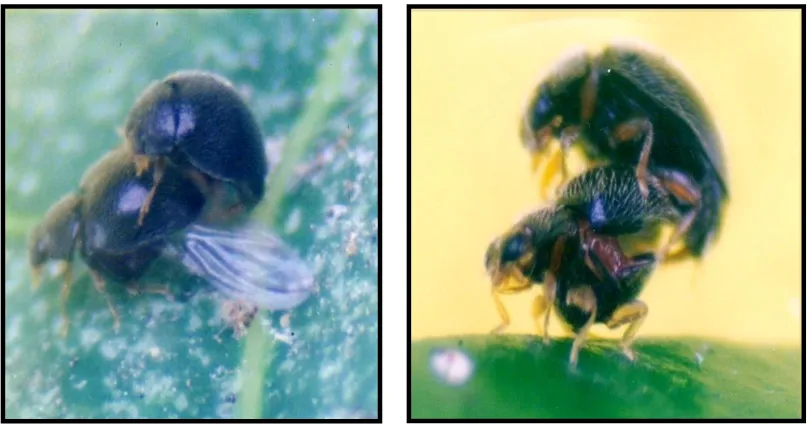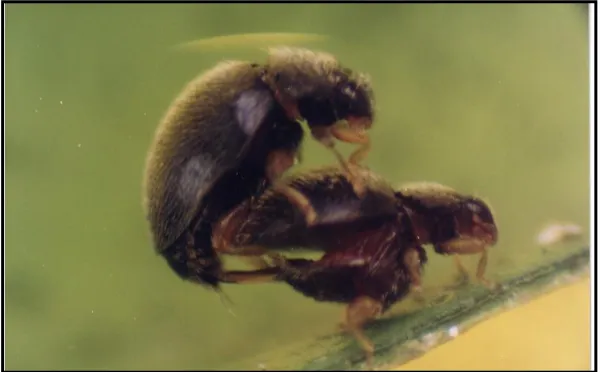http://dx.doi.org/10.17503/Agrivita-2012-34-1-p007-013
LIFE-HISTORY TRAITS OF
Stethorus gilvifrons
(MULSANT)
(Coleoptera: Coccinellidae)
ON PHYTOPHAGOUS MITES
Eutetranychus orientalis
KLEIN (Acari : Tetranychidae)
Handoko1*) and Affandi 2)
1*)
East Java Assessment Institute for Agricultural Technology Jl. Raya Karangploso KM.4 Malang 65152, East Java Indonesia
2)
Indonesian Tropical Fruit Research Institute
Jl. Raya Solok-Aripan Km 8 P.O. Box. 5 Solok-West Sumatera, Indonesia *)
Corresponding author Phone: +62-341- 494052 E-mail: ndoro_ndoko@yahoo.com
Received: July 12, 2011/ Accepted: January 26, 2012
ABSTRACT
The research aims to know the life cycle, feeding and mating behavior of predatory beetle S. gilvifrons, and was conducted at entomology laboratory of Assessment Institute for agri-cultural technology Malang - East Java. The treatments involved feeding behavior and capacity of the various instars and imago of S. gilvifrons. The number of mites consumed within 24 hours by each stage of beetle was also recorded. The average voracity of five individual predators for each instar was determined. The result showed that average life cycle of S. gilvifrons feed on E. orientalis was 4.11 + 0.78; 8 + 1.10; 3.83 + 0.41, respectively for egg, larva and pupa. The predator caught the preys from the front side, then chewed and sucked the body contents of adult preys or consumed the whole
Sustainable agriculture and food safety are major issues that call for judicious use of pesticides. The Indonesian government, in
response, institutionalized the integrated pest management (IPM) concept in agriculture. The decision to use IPM was also strengthened by the realization that pesticide use in many high value commodities has resulted in the development of insecticide resistant pests, undesirable residues in crops and contamination of environment. IPM emphasizes on the use of biological control agents such as predators and parasites, planting of resistant varieties, sanitation and other cultural methods, and chemical control as a last resort (Stern et al., 1959; Kogan, 1998; Untung, 2000).
frequently in order to produce fertile embryos (Putman, 1955).
The continuous presence of this predator and its capability to feed on several species of spider mites aroused the interest of the author to work on the area of biological control. The beetle was brought to the Philippines and was identified as Stethorus gilvifrons (Mulsant) (Coleoptera: Coccinellidae) by Ms Jessamyn Adorada, a coccinellid systematist from National Crop Protection Center. This was the first report of the presence of this species in Indonesia, specifically in East Java.
There is a dearth of information about S. gilvifrons in the literature. Few articles published were from Iran and Turkey. Haji-Zadeh et al. (1996) and Afshari et al. (2001) reported that S. gilvifrons could feed on eggs and adults of Panonychus ulmi, Tetranychus urticae, T. turkestani and Oligonychus sacchari by sucking their tissues after destroying the exoskeleton. Its feeding capacity was high and specific in both larval and adult stages. Its searching capacity and activity were highly constant over a wide temperature range. It was found that adult beetles preferred high prey density. With addition of prey density, the duration of different instar larvae decreased and feeding capacity increased. The feeding capacity of adult beetles increased when the temperature was raised to 400C (Roy et al., 2002). Base on the rationale above, this study was proposed to generate basic information on life-history, feeding and mating behavior of predatory beetle S. gilvifrons for future eco-logical on Integrated Pest Management program in this country.
MATERIALS AND METHODS
The study was conducted at entomology laboratory of Assessment Institute for Agricultural Technology Malang - East Java, from November 2003 to June 2004. Adult S. gilvifrons were collected from papaya plants using a mouth aspirator. The beetles were placed in cylindrical plastic cages (10 cm in diameter and 20 cm in height) to mate. The copulating beetles were then transferred into 3-month-old papaya plants planted in polybags which were previously infested with mites (Eutetranychus orientalis Klein). The mites were collected from papaya plants grown at Karangploso Experimental Farm - Malang.
To determine the life cycle, 100 S. gilvifrons eggs were picked up from the mass culture and were placed singly on Huffaker cells. The eggs were observed daily for color change and hatchability. The newly emerged larvae were fed with Eutetranychus orientalis Klein on papaya leaf until pupation. To prolong the freshness of the papaya leaf, a piece of wet tissue paper was placed under the leaf. The larvae were observed daily for its larval and pupal duration. Egg, larva and imago were measured under a binocular microscope.
The feeding behavior and capacity of the various instars and imago of S. gilvifrons were also evaluated. One beetle was introduced into several prey on specific host such as an orange (Panonychus. citri McGregor), apple (Eotetra-nychus cendanai Rimando) and rose (Oligonychus biharensis Hirst) leaf that had been previously infested with mites as follows: 10 mites for the first instar, 20 for the second instar, 40 for the third instar and 70 for the fourth instar and imago. Each leaf was enclosed with a 10 cm diameter x 15 cm long cylindrical cage. The number of mites consumed within 24 hours by each beetle was recorded. The average voracity of five individual predators for each instars was determined. Collected data was analyzed by analysis of variance, and to know the significant different among the treatment, Tuckey test was used at p= 0.05 %.
Mating behavior was also studied during the process of transferring adult predators from mass culture to the various cages, including the mouth aspirator, small vial (1.5 cm diameter x 7.5 cm long), small cylindrical plastic cage (10 cm diameter x 20 cm long), big cylindrical plastic cage (27 cm diameter x 70 cm long), and during mass rearing of the beetle in 60 cm diameter muslin cloth cage. Mating behavior was described by number of days before the first acceptance of female to male, site and time of mating, and position of the beetle during mating.
RESULTS AND DISCUSSION
Life Cycle of Stethorus gilvifrons
when first laid but gradually changed to light red as the time went on.
Larvae were gray to dark red, alligator-like with 13 segments and three pairs of prominent legs. Larvae grew from less than 1 mm to about 2.0 mm in length, comprised four instars. The last instar remained inactive before attaching its posterior part to leaf surface to pupate. Pupae were uniformly dark and flattened with prominent wing pads and bear posterior with white larval exuvia.
The newly emerged adults were light brown, and then gradually turned black from anterior to posterior. They were about 1.5 mm long and 1.2 mm wide (Figure 1), and relatively smaller than other coccinellids. They posed yellow legs and hard and thick forewings which were covered with slightly long and smooth white hairs. A few hours after emergence, the adults started searching for preys and mates. The partial life cycle of this predator is presented in Table 1.
A
B
D
C
E
G
F
Male and female of S. gilvifrons have oval body shape. Ventrally, the posterior part of the male body was pointed while the female’s was blunt. The terminal portion of the abdomen was rounded and hairy in males but flattened without hairs in females (Figure 2). The Male:female ratio of the insect was 1:1.34.
Feeding Behavior
The Stethorus predator fed from the front or the side of the prey. Predators usually
chewed and sucked the content of their prey by inserting their mouthparts (mandible) into body regions of the prey (Figure 3). The predator chewed and consumed the whole egg. Feeding capacity was greater in egg-laying than that in non egg- laying females and males (Haji-Zadeh et al., 1996; Afshari et al., 2001).
Table 3 shows that prey’s host significantly affected the feeding capacity of S. gilvifrons.
Table 1. Developmental stages of S. gilvifrons at 27 0C and 80% RH
Stage Duration (days) Mean Number of individuals
Egg 3 – 5 4.11 + 0.78 100
Larva 7 – 10 8 + 1.10 60
Pupa 3 – 4 3.83 + 0.41 60
A
B
Figure 3. (A) Larva and (B) adult of S. gilvifrons feeding mite
A
B
Table 3. Feeding capacity of Stethorus gilvifrons on mites Panonychus citri of orange, Eutetranychus cendanai of apple, and Oligonychus biharensis of rose
Preys
Number of mites fed by stages of S. gilvifrons
Instar-1 Instar-2 Instar-3 Instar-4 Imago
P. citri 2.600 a 5.600 a 14.40 a 52.60 a 52.20 a
E. cendanai 1.400 b 3.400 c 9.800 b 40.40 b 44.00 b
O. biharensis 2.400 a 5.000 b 13.20 ab 44.00 ab 49.20 ab
Remarks= *) values within column followed by different letters differ significantly under Tuckey-test 5 %
Mating Behavior
Until four days after emergence, mating was not observed on one or several pairs of adult S. gilvifrons placed in 27.5 cm in diameter x 70 cm in height of cage. However, it happened when a pair of adults was placed in a smaller cage (10 cm in diameter x 20 cm high). The mating activities were even more frequently observed when the beetles were placed in a much smaller cage (1.5 cm in diameter x 5 cm high), and mouth aspirator as well. These conditions implied that the size of the cage was a major factor to the successful mating of reared S. gilvifrons. A smaller cage contributed to the frequent contact between male and female adults which stimulated mating activities. Mating was also observed to be more frequent during
clear weather either in the morning or in late noon and less frequent during cloudy weather. Similar research by Taghizadeh et al., (2008) and Perumalsamy et al., (2010) was showed that temperature and relative humidity greatly affected fecundity, survivorship and life-table parameters of S. gilvifrons, and that 35°C was a suitable temperature for population growth of this predator.
The predators moved and searched for female when mating time came. However, not all of the females were willing to mate. To resist the male advances, the female would expand its fore wings, move in circles until its energy was spent, and then it would expand its second pair of wings and die (Figure 4).
Figure 5. A pair of mating S. gilvifrons
Figure 5. A pair of mating S. gilvifrons
Mating usually occurs on the upper leaf surfaces. One mating period can last for more than one hour. The male positioned itself over the female body and extended its aedeagus to reach the female (Figure 5). The male exhibited minimal movement during copulation. In S. panperculus, on the other hand, the anterior part of the male moved from left to right directions during the mating process.
CONCLUSIONS
Average life cycle of S. gilvifrons fed on E. orientalis was 4.11 + 0.78; 8 + 1.10; 3.83 + 0.41, respectively for egg, larva and pupa. S. gilvifrons fed from the front or the side of the prey, then chewed and sucked the body contents of adult prey or consumed the whole egg. Feeding capacity was greater in egg-laying than that in non egg-laying females and males.
The smallest size of the cage and clear weather were situation preferred for mating of S. gilvifrons. Mating occurred on the upper leaf surfaces, and male positioned itself over the female body and extended its aedeagus to reach the female.
REFERENCES
Afshari, A., M.S. Mossadegh and K. Kamali. 2001. Feeding behaviours of the ladybird beetle, Stethorus gilvifrons (Mulsant), and effect
of different factors on its feeding rate in laboratory condition. The Scientific Journal of Agriculture. Shahid Chamran Uni-versity, Ahvaz, Iran. 23(2).
Arbabi, M. and J.Singh. 2008. Biology of Stethorus punctillum, a potential predator of Tetrany chus ludeni. Tunisian Journal of Plant Pro-tection 3: 95-100
Biddinger, D.J., D.C. Weber and L.A. Hull. 2009. Coccinellidae as predators of mites: Stethorini in biological control. Biological Control 51:268-283
Chazeau, J. 1985. Predaceous Insects. In. Helle, W. and M.W. Sabelis (ed). Spider mites their biology, natural enemies and control. 16: 211 – 246.
Haji-Zadeh, J., K. Kamali and M.S.Mossadegh. 1996. Studies on the feeding behavior of Stethorus gilvifrons Mulsant. The Scientific Journal of Agriculture. Shahid Chamran University, Ahvaz, Iran. 18:1-2.
Hodek, I. 1967. Bionomics and ecology of predaceous Coccinellidae. Annual Review of Entomology 12: 79 – 104.
Kalshoven L.G.E. 1981. The Pest of Crops in Indonesia. Revised by P.A. Van der Laan. P.T. Ichtiar Baru - Van Hoeve Publishers, Jakarta. Indonesia. pp.701.
Kovář, I. 1996. Morphology and anatomy. pp. 1-18. In: Hodek, I and A. Honěk (Eds.) Ecology of Coccinellidae. Kluwer Academic, Dordrecht. pp.464.
Perumalsamy, K., R. Selvasundaran, A. Roobakkumar, V.J. Rahman and N. Muraleedharan. 2010. Life table and predatory efficiency of Stethorus gilvifrons (Coleoptera: Coccinellidae), an important predator of the red spider mite, Oligonychus coffeae (Acari: Tetranychidae), infesting tea. Experimental and Applied Acarology. 50(2): 141-150.
Pollock, D.A. and G. J. Michels Jr. 2007. Bionomics and distribution of Stethorus caseyi Gordon and Chapin (Coleoptera: Coccinellidae), with description of the mature larva. Southwestern Entomo-logist 32(3):143-147.
Putman, W. M. L. 1955. Bionomics of Stethorus punctillum Weise (Coleoptera: Cocci-nellidae) in Ontario. Canadian Entomo-logy 97 (1) : 9 – 33.
Roache, L.C. 1960. Ladybug, Ladybug: What's in a Name? The Coleopterists Bulletin 14(1): 21-25.
Roy, M., J. Brodeur and C. Cloutier. 2002. Relationship between temperature and developmental rate of Stethorus punctillum (Coleoptera: Coccinellidae) and its prey Tetranychus mcdanieli (Acarina: Tetranychidae. Environmental Entomology 31(1):177-187.
Roy, M., J. Brodeur and C. Cloutier. 2003. Effect of temperature on intrinsic rates of natural increase (RM) of a coccinellid and its spider mite prey. Biological Control 48(1): 57 – 72.
Roy, M., J. Brodeur and C. Cloutier. 2005. Seasonal activity of the spider mite predators Stethorus punctillum (Coleop-tera: Coccinellidae) and Neoseiulus fallacis (Acarina: Phytoseiidae) in raspberry, two predators of Tetranychus mcdanieli (Acarina: Tetranychidae). Biological Control 34(1): 47-57
Stern, V.M., R.F. Smith, R. van den Bosch and K.S. Hagen. 1959. The integrated control concept. Hilgardia 29: 81-101. Taghizadeh, R., Y. Fathipour and K. Kamali.
2008. Influence of temperature on life-table parameters of Stethorus gilvifrons (Mulsant) (Coleoptera: Coccinellidae) fed on Tetranychus urticae Koch. Journal of Applied Entomology, 132(8): 638-645.



